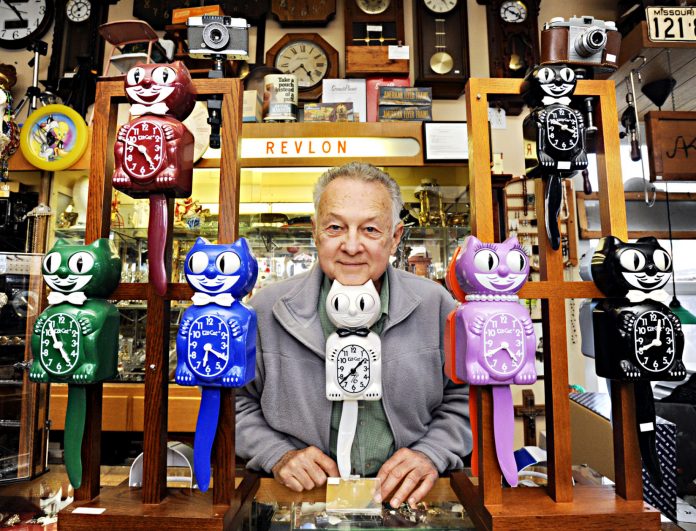
Ronald Paulk keeps typewriters, clocks and watches ticking. For the Hollister resident, it’s not just a job. It’s a hobby.
At his Mission Clocks & Watches shop at 217 Third St. in San Juan Bautista, Paulk, 71, sells wrist watches, clocks, typewriters, lighters and antiques. He stays in business, though, by changing watch batteries and fixing time-telling instruments of all sizes.
“What pays my bills is repair work,” Paulk said.
The shop—500 feet from the San Andreas fault line and with a view of the San Juan Bautista Mission—has a heartbeat of its own with more than 500 clocks tick-tocking out a rhythm.
Paulk’s journey into the world of clock repair work started in 1965 when he joined the Navy and put several years of experience repairing office supplies to use as an instrumentman on the USS Prairie. He calibrated steam and pressure instruments, and adjusted clocks, stopwatches and wristwatches.
“I never worked on a clock ’til I got in the Navy,” Paulk said.
After serving in the Navy, Paulk pursued a 27-year career working on computer hard drives before he eventually returned to his interest in time-telling instruments by starting a repair business in Oklahoma. Eventually, he moved that business to California.
Typically, Paulk’s customers are 60 to 65 years old and bring in clocks that they’ve had for a long time. Some clocks have been retirement gifts. Others came from weddings.
Paulk still remembers a client who brought him a pocketwatch with a dent and asked him not to touch the warped part.
The man’s father had used a plow. When he pulled the handles against his chest, the pressure put a dent in the pocketwatch that his son wanted to keep.
“The young people hardly don’t wear watches anymore because it’s on their cell phone,” Paulk said. “I think they don’t want the old stuff anymore … but it’s a cycle so I think it will come back around again.”
Sean Yoshinaga agrees with this. He is the owner and master watchmaker of Village Watchmaker in Los Gatos. In fact, Yoshinaga takes Paulk’s view of the watch trend a step further and suggests that smart phones are great for alarms and casual time telling, but aren’t as classy as a wristwatch for younger people in a professional setting.
“Kids don’t really like watches—high schoolers, college kids—but as soon as they get out and they find a pretty good job that they’re in, they come in looking for watches,” he said. “When you’re younger and you’re starting out as a professional you don’t want to be in a meeting and seen pulling out your phone.”
According to Yoshinaga, men wear watches for two reasons: They like the artistry and mechanics, or they want to show they have money.
“Then you have the other types of people that want to wear it more as jewelry or a status symbol, and that will never change,” Yoshinaga said.
Paulk’s profession is a specialty niche and the watchmaker is aware of the changing times, but there’s plenty of business at his shop. While there were once 50,000 watchmakers in the nation, now there are likely less than 4,000 working in that trade, Paulk remarked.
Some of his clients hold him in great esteem, something that was clear in a handwritten, cursive postcard Paulk received from one happy customer who penned a note Nov. 27, 2013 after the watchmaker repaired a cuckoo clock that had been out of commission for years.
The writer, Laurie Jones, had purchased the clock while visiting Germany with a friend more than 27 years ago. It fell into disrepair after her brother-in-law took the instrument apart.
“I’m so glad God blessed you with this incredible talent to repair cuckoo clocks,” read Paulk. “Thank you. Thank you. Thank you.”
The store has a touch of the eccentric with a pair of longhorns that stretch six feet from tip to tip—a possession Paulk inherited from his father—hanging over the font door. There are also signs from an Oklahoma drugstore and license plates that once graced his grandfather’s black four-door 1946 Buick on the wall.
Then there are the grandfather, grandmother and granddaughter clocks— defined by their heights, widths and areas of origin—several of which are more than six-feet tall. Paulk doesn’t sell many of these, but he makes house calls to Morgan Hill, San Martin, Aromas and Hollister to take them apart and oil the pieces.
“They’re so expensive and the people who really like them are usually retired and on fixed income,” Paulk said.
After owning the land for his shop for 10 years and running a business there for five years, Paulk’s joy in his work comes from what he knows best: the puzzle of fixing clocks and watches.
“They’re all different,” the watchmaker said. “Very seldom do you work on two that are alike.”









